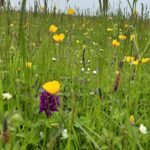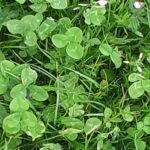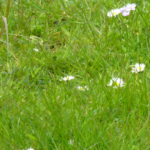Pasture Champions: The Bown Family, New Holland Farm, Orkney 1/3
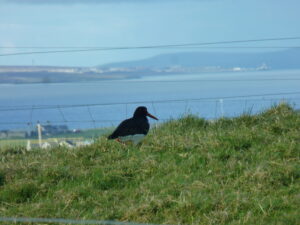 New Holland Farm, Orkney
New Holland Farm, Orkney
Tell us about your farm – location, size, altitude, climate, soils, enterprises, organic/PfL and other status
We have been farming here on Orkney for over thirty years and have been farming organically since 1999.
Orkney is an island off the north coast of Scotland. John o’ Groats is “sooth” from us.
We live on the biggest island of Orkney called “the Mainland”.
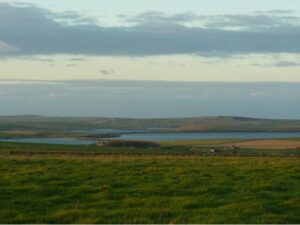 Orkney
Orkney
As you can see Orkney is a green fertile place which grows grass well but trees not so well. Most of the land is sprayed with sea salt regularly which perhaps adds to the fantastic flavour of Orkney produce but has its challenges too. Orkney is very windy and many farmers including us have made use of this resource building wind turbines.
We have a beef suckler herd with 200 cows and their followers. Orkney is famous for its beef and boasts the highest concentration of beef cows in Europe.
We also have around 400 ewes which we lamb outside in April/May. We have been members of PFLA since 2016.
What you do to encourage biodiversity?
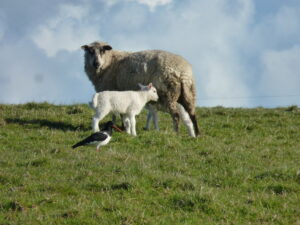 Encouraging diversity
Encouraging diversity
There are four main ways which we encourage biodiversity on our farm:
1. Soil and sward management
2. Mob Grazing
3. Delayed silage making
4. Creating connected pockets of wildlife habitat across the farm
Soil and sward management
Almost all of our land is permanent pasture or maritime heath rough grazing. We want to give the biology in the soil the best chance to thrive by disturbing it as little as possible.
We also ensure the optimum environment for soil microbes by balancing the soil calcium/ magnesium ratio using the Albrecht system, with local shell sand and dolomitic limestone. These relatively cheap inputs make an enormous difference to the productivity of the field.
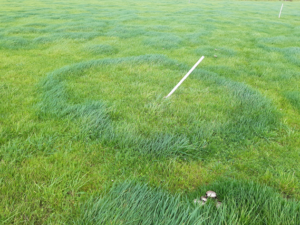 Sward
Sward
Our soil is high organic matter soft peaty organic soil (Organic matter 8-36% with most fields 12-15%). This means the cattle easily damage the fields in wet weather. The dense permanent sward helps mitigate this, although we do have to house cattle in the winter to prevent more severe damage.
The fields have not been ploughed for about 25 years. When we feel a field would benefit from it, we use an Aitcheson drill to sow seed into the sward.
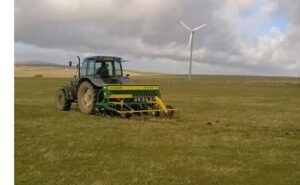 Seeder
Seeder
Mob Grazing
We mob graze all our cattle and most of our sheep. This has had a huge positive impact on our diversity of plants species in the sward.
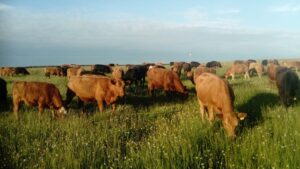
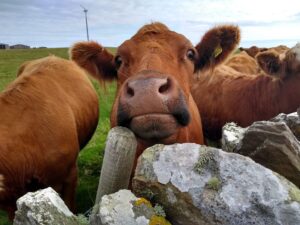 Mob grazing cattle
Mob grazing cattle
We have mobs of around 75 cows plus calves in a 2-acre paddock. They are moved daily. Electric fences divide up the fields into paddocks. The exact size of paddock, number of animals and length of time all vary depending on weather and grass growth rate. Mob grazing is not an exact science.
We have gained confidence since we began, to trust our own judgement about what is right for our own farm and that’s ok!
Apart from the increase in plant species, the mob grazing has another huge benefit. The cattle learn the system and become much more easily handled and content.
Although hedgerows are absent in Orkney, some of our fields are surrounded by drystone dykes. These provide a windbreak, but also are micro-habitats themselves.
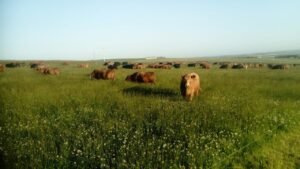 Contented cattle mob grazing
Contented cattle mob grazing
The mob grazing is slowly increasing the biodiversity in our pastures.
- Orchid
- Clover
- Milkmaid

